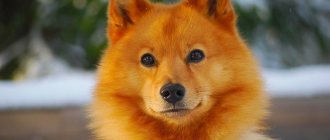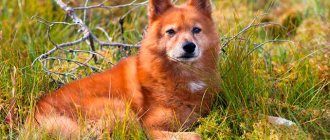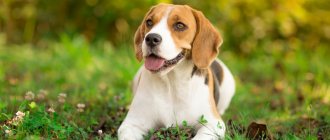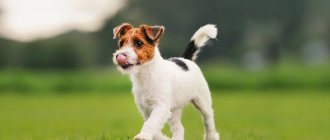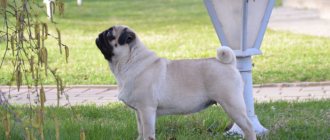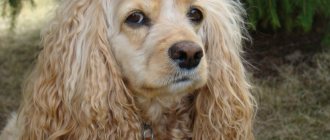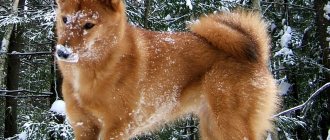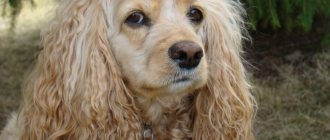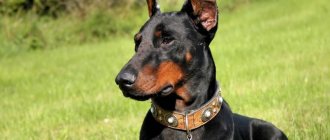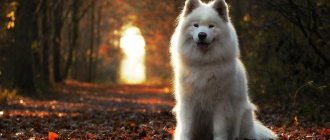The Finnish Lapphund or Finnish Lapphund (English: Finnish Lapphund, Finnish: suomenlapinkoira) is a hardy, calm, medium-sized dog breed native to the northern regions of Finland. The Finnish Lapphund was traditionally kept by the Sami, who have bred these dogs since time immemorial. The semi-nomadic Sami used it as a hunting dog, herding dog and livestock guardian, although in recent centuries the breed has been used mainly for herding reindeer. The breed is very popular as a companion dog in Finland, where it is regularly ranked among the top ten most popular dog breeds, but is very rare outside of Scandinavia.
Description and features
Lapphund is breed ; it is the name for several types of dogs. Now they are separated by geographical location and some difference in appearance, but they are united by belonging to the same group of northern Spitz and a common purpose.
They are considered medium in size, with strong bones and thick hair, which allows them to work and exist in harsh arctic conditions. The body format can be considered almost square, the skull is wide, with a convex forehead, the muzzle is not long, the triangular ears are thick and tightly set.
It is characterized by a large collar on the neck, sometimes turning into a mane. It gives the image a certain "lion" look. The paws are powerful, with dense pads. The tail is usually curled towards the back. In all varieties, females differ from males in having a more graceful physique, gentle disposition and complaisance.
Lapphunds are energetic and cheerful dogs.
Their behavior and disposition fit well into three concepts - brave, cheerful and friendly. Dogs are not against new acquaintances and show interest in unknown people. Aggressive behavior is not typical for them. But it’s difficult to call them too trusting. More like condescending good nature.
A loud bark, excellent sense of smell and hearing - these are the tools with which they communicate, enter into social contact, live and work. If you add to this intelligence, obedience and endurance - in the North you cannot live without these qualities - you will get an excellent assistant in almost any task.
Not only can they do herding work, but they can also be rescuers, hunters, and companions. Such animals make excellent watchmen, but not security guards; they are too soft for such service.
Characteristics of the Finnish Lapphund
| Attachment level | Average |
| Friendliness | Average |
| Child friendly | High |
| Loyalty to other pets | Average |
| Exercise needs | Average |
| Playfulness | Average |
| Energy level | Average |
| Learning ability | High |
| Intelligence | High |
| Tendency to bark | High |
| Shedding amount | High |
Kinds
— Finnish Lapphund (suomenlapenkoira, Finnish Lappish husky). Popular not only in Finland, but also in other northern countries. Since ancient times, they have been used to transport goods and move themselves on sleds. They also helped herd the deer into their stalls. But the breed was taken seriously and purposefully only in the 20th century.
And the first breed standard appeared only in 1945. The FCI recognized dogs even later, in 1955. Weight ranges from 25 to 30 kg, height of boys - 46-52 cm, girls - 40-46 cm. The head is in the form of a wedge, the arches above the eyebrows are pronounced, the jaws are powerful, with large teeth that fit quite tightly.
Scissor bite. The nose has a movable, black nose at the end. The eyes are oval, preferably a deep brown color. The ears are triangular, all covered with fur, always turned towards the place of sound. The back is straight, of medium length. Well developed muscles. The chest is deep. The legs are long and straight.
The front ones have strong shoulders, but the hind ones are stronger due to larger bones. The location is parallel. Profit fingers are usually removed. The tail is medium, with a curved tip, generously covered with hair, set quite high. A calm dog holds it freely and slightly lifts it above its back while working.
The fur is dense with a thick soft undercoat. The variety in colors makes it impossible to often see two identical Lapphunds. The main condition is that only one shade dominates the color. The character is calm, self-sufficient, devoted. They get along well with all family members, including children of all ages.
They are unlikely to conflict with other pets - they will try to find a common language. Only sometimes the most zealous males can compete with their own kind. They are distinguished by vigilance, intuition, and restraint.
The Finnish Lapphund in the photo looks like a teddy bear, you just want to pet it, cuddle it, cuddle it, pat it on the head. However, it is better to show gentle restraint towards dogs of non-decorative breeds.
Possible colors of Finnish Lapphunds
Swedish Lapphund
— Swedish Lapphund (Lapland Spitz). The appearance and character are very reminiscent of their Finnish counterparts. But if they are decorated with a lush mane and a color more similar to a wolf, then Swedish huskies often have a charcoal or black and tan color. What can you do if the Swedes liked these colors?
They say that they assigned such dogs the role of liaison between people and the other world, maybe the black lapphund was more suitable for this mystical purpose? Laikas accompanied nomadic tribes, protecting them from predators and guarding their unwise belongings.
Swedish dogs have the same fluffy coat, although you can find two varieties - long-haired and short-haired. For work, preference was given to the latter, because long fur in the cold can freeze and interfere with the animal. But the purebred nature of the breed, restored in the 30-40s of the last century, is often based on long hair. The standard was approved in 1944, the FCI recognized the breed in 1955.
Swedish Lapphunds
Lapland Vallhund
— Lapland Vallhund (Lapinporokoira, Lapp Reindeer Dog or Lapland Herder). These representatives clearly do not resemble bear cubs, unlike the previous ones. They look almost like shepherds, only the erect triangular ears and softness in their eyes give them away as Spitz.
Their physique is characterized by an elongated format. The coat does not look as luxurious and voluminous as that of other Lapp huskies, but it is still thick, dense and with a warm undercoat. The head is more elongated, the tail is set low and does not curl towards the back. In its normal state it hangs just below the level of the coccyx.
The dog never expresses emotions with the help of his tail - he does not move it, does not wave or rotate it. For a long time, the reindeer dog was one species along with the Finnish husky, but since 1966 they have been officially recognized as two different breeds. The IFF recognized them in 1970. The usual color is black in various shades (from gray to brownish) with rare white inclusions (tan) on the chest, paws and neck.
Now it is difficult to say which of the three above-mentioned breeds was the first. Perhaps the reindeer dog initially united all species, and then gradually divided into different branches. And it’s even more likely that they all arose approximately simultaneously in ancient times from the need to protect domesticated reindeer, without which people in the North cannot live.
Be that as it may, Finnish Lapphunds can be seen on ancient magic drums of northern shamans, Swedish ones - on ancient chronicles and drawings of nomadic tribes of Scandinavia, and the Lapp reindeer dog was first described in Roman books and chronicles at the dawn of the 1st millennium. In any case, all work on systematic breeding dates back to the last century.
Lapland Vallhund
Character
Cheerful, good-natured Finnish Lapphunds will perfectly find their place in almost any family. They get along well with children and get used to other pets. They are not aggressive and will not rush at any stranger. And first they will see if the owners are happy with this person. They are alert, curious and observant. And in case of danger for the owner, the enemy will receive a decisive rebuff. In addition, Lapp huskies—that’s what they are huskies for—have a loud, ringing voice and excellent sense of smell—the owners learn about potential danger in advance.
Care and maintenance
Ideal living conditions are a private house with a yard. It is advisable for Laikas to live outside, they are not afraid of frost, they can sleep in the snow. In this sense, heat is much more unpleasant for such dogs. Therefore, in an apartment they often experience discomfort and can shed profusely and for a long time.
The main thing that a Lapphund owner should know is the need for long walks and diligent training. The hunting instinct pushes them to adventure, so you need to watch your pets especially carefully when walking. If any animal appears within sight, the dog will almost certainly rush after it.
Persistence and patience are what the owner must show in raising a puppy. All Lapphunds are receptive to training and training, but their natural independence can make things a little more challenging.
Therefore, do not be deceived by reviews about the breed’s intelligence and intelligence; start training from an early age. Otherwise, the pet will get out of control. Several rules must be followed:
- regularity of training;
- training is strict, but without cruelty, with respect;
- try to diversify your activities, otherwise your pet’s lively mind will quickly switch to another object;
- the load must be calibrated and sufficiently intense;
- a single walk should be at least 40-50 minutes, including the active component - running, games.
There are not many problems in terms of care. Despite its thickness, the fur does not tangle, does not form tangles, does not get dirty and does not smell. A special brush is required for long hair. If the dog lives in the house, the combing procedure is performed every two days. It is enough to comb a street resident once a week. During shedding, the fur needs to be brushed more often.
Bathing with shampoo is enough once every 2-3 months. Regular examination of the ears and eyes is part of weekly hygiene. The nails can be ground down on their own, but you can buy a nail clipper for your pet dog. And teeth are brushed once a week. Dogs are in good health, but there are also breed-specific diseases. These are dysplasia of large joints, urolithiasis and inflammation of the visual organs.
This breed does not require special nutrition
History of the breed
Little is known about the origins of this breed. It was first bred hundreds of years before the advent of writing in the area where it originated, and in any case it was bred exclusively by semi-nomadic peoples. It is obvious that the Finnish Lapphund was already bred by the Sami when it first appears in the chronicles, and that it is closely related to many other Scandinavian and Russian dog breeds, such as the Spitz.
Historically, the Sami were known as Sami, and the breed's first name was Sami Shepherd, but the term is now considered outdated, derogatory, and somewhat offensive.
Although the dog (and also the wolf) is one of the most adaptable animal species, the first dogs were poorly adapted to life in the northernmost regions of Europe and Asia. These dogs, bred to survive in tropical climates, could not cope with the low temperatures that characterized the region.
The inhabitants of this region began crossing their dogs with various subspecies of wolves found in northern Eurasia, which were larger, fiercer, and had longer hair and thicker fur than those found elsewhere. These crosses resulted in the Spitz, which performed the same functions as its dingo-like ancestors, only in a much colder environment.
Because much of Scandinavia was inaccessible to humans during the Ice Age, many theorists believe that Spitz-like dogs accompanied the first humans to the region, although this is also disputed. Archaeological excavations in Norway date back to around 4000 BC and prove that the Spitz has indeed lived in northern Scandinavia since at least 6000 BC.
The Sami are the northernmost indigenous people of Europe. Historically, the Sami inhabited a vast area of tundra and forest that is today divided between Norway, Sweden, Finland and Russia. The Sami were the last European hunter-gatherers, using the Finnish Sami ancestors to hunt deer, bear, elk and other large mammals and to guard their settlements.
Gradually the Sami began to herd the reindeer they had previously hunted. Wolves exhibit natural behaviors such as stalking, biting, and circling while hunting, which are useful for surrounding herds and selecting the weakest members to attack. Sami breeders began to emphasize these traits in their dogs so that they could more effectively help herd reindeer.
The result was a highly intelligent and trained dog, capable of herding herds in the coldest and harshest conditions on Earth.
Although the Sami maintained very close relations with the Scandinavian and Finnish-Estonian peoples to the south for thousands of years, they largely retained their traditional way of life until the 16th and 17th centuries. In fact, the Sami were the last significant pagan people in Europe.
This isolation meant that the Finnish Lapphund remained almost entirely purebred to this day. Despite official occupation by foreign powers for centuries, the Sami lands were so undesirable for settlement that most Sami lived as semi-nomadic reindeer herders until the 20th century and continued to breed Finnish Huskies exclusively as herding dogs.
However, changes eventually occurred even in the most isolated regions. In the 1930s, technologies such as snowmobiles and railroads arrived in the region, greatly improving contact with the outside world. Foreign dogs began to arrive in Sami areas, bringing diseases with them. The Finnish Lapphund, almost completely isolated from other dog populations, was immune to diseases such as distempera, and a series of major epidemics occurred.
These dogs were dying at such a rate that many experts feared the complete extinction of all Lapphunds.
Fortunately, in the 1930s, Swedish and Finnish dog breeders became interested in standardizing Sami herding dogs (then called Sami Shepherd Dogs). Up to this point, the Finnish Sami breeds were extremely varied in appearance, although most shared some common traits.
Breeders began to roam the Sami lands in search of the best preserved specimens of these dogs. At that time there were several Finnish kennel clubs, some of which had their own Sami dog breeding programs. Swedish breeders preferred exclusively black dogs, which ultimately led to the emergence of the Swedish type of dog. A group of Finnish breeders preferred short-haired Sami dogs.
Another group of Finnish breeders preferred long-haired Sami dogs. In 1960, various Finnish dog breeding organizations merged into one dog breeders club. They decided to create a single standard for the Finnish Lapphound, giving the breed the name Lapinkoire, which means “Sami dog” in Finnish.
However, in 1966 it became clear that these two different varieties should be officially separated. The following year, the shorthaired dog was officially recognized as a separate breed.
In 1975, the standard of the Finnish Lapphon was changed in accordance with the standards of the International Kennel Federation (FCI). For similar reasons, the standard was revised again in 1993. In 1993, the breed's name was officially changed to Suomenlapinkoira or Finnish Lapphund to better distinguish it from the Swedish Lapphund.
Efforts to standardize the Finnish Lapphund have greatly increased the breed's popularity in its homeland. The Finnish Lapphund has become one of the most popular breeds in Finland over the past few decades, regularly ranking among the top ten most registered breeds in the Finnish Kennel Club.
This dog is very well known in Scandinavia due to its excellent temperament, high trainability and ability to live even in the coldest climatic conditions of the region. In fact, according to Finnish law, the Finnish Lapphound is one of two dog breeds that are legal to keep outside.
The Finnish Lapphund became an increasingly popular family companion and show dog, but became less and less popular as a service dog. Changes in the reindeer breeding practices of the Sami and Finns have resulted in the short-haired dog becoming much more popular as a working dog.
Although a few members of the breed are still used as working herding dogs, the vast majority of the stock are now family companions and show dogs.
Currently, Finnish Lapland Huskies remain a very rare breed in Europe and the United States, but their numbers are growing. Although its popularity will probably always be limited by its difficulty adapting to the warm climate of most warm countries, its future looks bright in more northern countries.
Nutrition
An important point is a complete and correct diet. Typically, these dogs are kept outdoors, so they require high-calorie food, especially in winter. The food must include meat, porridge with meat broth or milk, vegetables and essential vitamins and minerals.
In percentage terms, most of it falls on protein foods - meat, fish, offal. About a third is allocated to cereals, dairy products, herbs and vegetables. Beans, potatoes, sweet and spicy foods are strictly not recommended.
If you choose ready-made food, it should only be of high quality. With this option, vitamin and mineral supplements are not necessary, since they are included in the feed. Food is given several times a day. And there should always be clean water in a separate bowl.
Feeding
The diet of any Spitz should be light, not too high in calories, but balanced. For dogs bred in cold conditions, these requirements are even stricter. The metabolism of tetrapods is designed so that the animal can survive with limited fat reserves and a not very rich diet. Simply put, the Swedish Lapphund needs to be fed well, but care must be taken to ensure that the pet uses up everything it eats.
Regardless of the type of diet, the Swedish Lapphund should receive soft and hard food. Solid foods, such as raw vegetables or large pieces of meat, are used to clean plaque from teeth. Soft, warm food is better absorbed (if we are talking about natural food).
Industrial food is also suitable for keeping the Swedish Lapphund, but there are more nuances:
- High quality food is super-premium and holistic class. These two classes are the most expensive products.
- Cheap food is full of dyes, preservatives, salts and other additives, which are guaranteed to provoke the development of urolithiasis, to which Swedish Lapphunds are prone.
- Dry granules should be alternated or mixed with canned food of the same brand and line.
Reproduction and lifespan
For Russia, the breed is considered quite rare; it can be seen only at the largest exhibitions. Therefore, breeding them yourself is difficult and unprofitable. Any owner will try to choose a nursery or breeder for purchase that has long been known and has proven itself well.
However, here is information for general information: the first estrus in females occurs at the age of 12-14 months, and it is better to breed from 2 years on 11-15 days from the beginning of estrus. On day “X” the animals are given a good walk, but there is no need to feed them. They are introduced to each other on neutral territory, allowing them to run around together. Mating is carried out on the territory of the male.
After 1-2 days, a control mating is carried out. Pregnancy lasts 62-67 days. There are 3 to 4 puppies in a litter, which can all be different colors. You need to choose a baby at the age of two months, and be sure to take into account his physical and psychological health. The ears, eyes and nose should be clean, the fur should be smooth and fluffy, with a uniform structure. Behavior is lively and fearless.
Lapphund puppies must undergo socialization so that they do not grow up restless and timid. At an early age, mom does this. As they grow older, the responsibility falls on the owner, in the form of education and training. Once in the house, the dog must understand that he is a member of the family like the others. Life expectancy is 13-14 years.
Finnish Lapphund puppy
Standards
The established standards give us the following description of the breed:
- The average height at the withers is about forty-seven centimeters.
- Permissible weight is about twenty kilograms.
- The body shape is square.
- The head is quite large, especially in relation to the body. The forehead is convex. There is a narrowing towards the nose.
- The ears are set wide apart, in the form of small triangles.
- The eyes are slightly elongated. The iris is always dark in color. Brown and black colors are allowed.
- The teeth are straight, white and have a scissor bite.
- The chest is wide.
- The stomach is taut.
- The back is strong and level.
- The limbs are long, straight and parallel to each other.
- The tail is set quite high, of medium length, and abundantly covered with hair.
To read: The smallest and fluffiest dog Yorkshire Terrier: the pros and cons of the breed
Our beauties have long and thick fur. Falls in straight strands. The hair on the nose and limbs is much shorter. The undercoat is dense, thick and warm. Only dark colors are allowed as a color. White color is always in the minority. It is usually located on the chest, head, neck, muzzle, paws and tail.
Price and owner reviews
Lapphunds are quite common in the north of the continent, but there are still few of them in Russia. Therefore, the acquisition will take a lot of time. It is important to find a trusted supplier. In private advertisements, offers for the sale of Lapp Laikas are rare. The price of a Lapphund is usually quite high - $1000-1500.
Along with the puppy, you must provide documents and a veterinary record. Then you will be sure that you have received a purebred pet without genetic diseases, with a good pedigree. If you plan to participate in exhibitions, the purchase may cost even more.
Owners say that the Lapphund dog is a distinctive breed with a lot of positive qualities. The main thing is manpower, activity, endurance, reliability. You will never get bored with her.
These dogs make not only competition participants, but also beloved family members. Some stubbornness and excessive curiosity can be corrected with training. The main thing is to find a common language with a friend and gain his respect and trust.
How to choose a puppy
- First, look at the puppy's parents and find out their age. It is better not to take Karelian-Finnish huskies from a too young couple (a female and a male are less than 1.5 years old).
- Don’t place too much hope on the working and championship diplomas of your baby’s mom and dad. Winners are not born, they are made.
- 6-week-old Karelian-Finnish Husky puppies should already have erect ears. However, there is a small percentage of animals whose ear flaps rise only by 3 months. In this case, it is better to wait an extra couple of weeks to determine exactly who is in front of you - a worthy representative of the Karelian family or a tiny impostor.
- Pay attention to the number of puppies in the litter. It's better if there are less than 6 of them.
- The quality of the baby’s coat is also important, but it should be remembered that the most spectacular “fur coats” are those of Karelian-Finnish huskies born in winter.
- Carefully study the pedigree of your potential pet. If the same nicknames with the same numbers are repeated in it, this indicates that the breeder is keen on inbreeding (inbreeding), and this is fraught with serious developmental deviations and external defects for the litters.
- Evaluate the gait of a Karelian-Finnish husky puppy. A healthy animal should have straight limbs without signs of rickets and move freely. If the puppy “thinks” before lying down or sitting down, not everything is fine with its musculoskeletal system.
- Ungroomed puppies with signs of a hernia, dirty ears and festering eyes undoubtedly evoke pity, but adopting such an animal means acquiring a whole host of problems and forever giving up the dream of walking around the ring with your pet.
Key points in training
The Finnish Spitz is a fairly smart breed that can easily master the commands of the basic set . Due to the fact that representatives of the breed mature slowly, it is better to start training a little later than other dogs. Spitz dogs can be stubborn, so training requires patience and persistence.
These dogs quickly lose interest if practicing commands is monotonous and lengthy.
It is advisable to carry out training in a playful way, diversifying it as much as possible; each exercise should be short in time, after which the dog’s attention should be switched. The Finnish Laika will not appreciate cruelty and the use of force.
Read about how to properly train a dog in the article: “Training a puppy: effective methods from dog handlers, learning commands at home.”
Brief historical background on origin
The Finnish Spitz, at the suggestion of a French gentleman, was spotted in his homeland, where he was especially popular among hunters. It is impossible to say exactly how ancient it is. During the war, like many others, she could have disappeared completely. At the end of 1880, she received a new impetus for life from amateurs who managed to increase the number and continue breeding.
Laika - “Karelian” received another, official name “Finnish Spitz” and went to neighboring countries. In the Russian Federation, on the territory of Karelia and St. Petersburg, there also remain a significant number of dogs that were actively bred by their neighbors - the Finns.
By the end of the 20th century, the dog mainly spread to America and EU countries. And to this day, in their historical homeland, their number greatly predominates.
